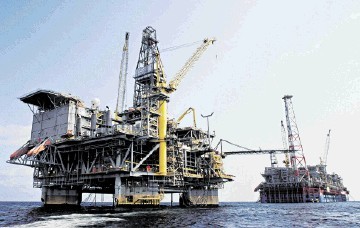
Like its ocean-crossing oil tankers, Exxon Mobil Corp.’s strategy can take some time to turn. When it does, the impact can be striking.
Since Darren Woods replaced Rex Tillerson as chief executive officer in January 2017, Big Oil’s biggest producer has quietly assembled a vast portfolio of new resources, pumping billions of dollars into exploration and acquisitions.
The goals: Revive a share price that’s lagged peers, reverse a long-term growth problem and outmaneuver rivals focused on paying down debt. The plan may be about to pay off, just in time to take advantage of oil’s recent surge.
“We really believe 2018 will be a turning point for Exxon” said Mark Stoeckle, who manages $2.5 billion including Exxon shares as chief executive officer of Adams Funds in Boston. “They’ll get credit for increasing reserves which hasn’t happened over the last couple of years.”
The world’s biggest publicly-traded oil producer will likely boost reserves by 7.5 percent later this month, reversing part of last year’s cuts, according to Cowen & Co. And that may be just a start, as the company expands in the Permian Basin in the U.S. and pushes offshore wells from Guyana to Papua New Guinea.
Boosted by rising oil prices, Exxon is expected to post fourth-quarter net income of $4.3 billion on Feb. 2, its highest for 11 quarters, according to 13 analysts surveyed by Bloomberg. Investing in lower-cost production may also allow the company to reintroduce share buybacks, according to analysts at Macquarie Capital and Scotia Howard Weil.
Exxon pledged to pay shareholders a 77-cent-a-share dividend this quarter, according to an emailed statement on Wednesday. The payout, unchanged from the previous level, will cost the company about $3.3 billion. Exxon last raised its dividend in April.
Replacing barrels
The company, whose $368 billion market capitalization dwarfs its competitors, will post its 2017 reserves later this month. Its investor day is March 7 in New York.
Replacing the 3.9 million barrels it pumps each day has been a long-term problem for Exxon. Output has dropped in four of the last five calendar years and the company produces 7 percent less now than in 2010, according to data compiled by Bloomberg Intelligence.
At the same time, the stock has underperformed BI’s gauge of global integrated oil producers over one, three and five years and recently lost its historic valuation price-to-book valuation premium over peers.
Profit vs. production
The performance has been “painful,” said Stoeckle, who said the market has been putting too much emphasis on production.
Shell Is Closing In on Exxon’s Title as the King of Oil and Gas
Indeed, Exxon has argued that profit margins are more important than the production volumes but it’s still a data point that concerns investors, according to Cowen’s Sam Margolin, the top-ranked integrated oil analyst for investor returns.
“If Exxon is lagging peers in one data point, that may be enough for investors to put it to the side,” Margolin said by telephone. “We’ve seen that in the stock’s performance.”
Two major deals struck under Tillerson, now serving as U.S. secretary of state under President Donald Trump, left Exxon’s upstream “disadvantaged,” Credit Suisse said.
Under Tillerson, who was CEO for 11 years, the company spent $35 billion purchasing XTO Energy in 2010, just before gas prices slumped. A year later, Exxon struck a deal with Rosneft PJSC to explore and develop giant offshore fields in Russia, before they were walled off by U.S. sanctions.
Exxon lifer
Woods, who joined Exxon in 1992, primarily managed the company’s chemicals and refining businesses before being tabbed as Tillerson’s replacement. Since gaining the top job, he has sought to arrest the decline in reserves by signing off on a flurry of acquisitions and by extending his predecessor’s push into Guyana, where the company has thus far discovered 3.2 billion barrels.
Exxon agreed to spend about $10 billion on assets in U.S. shale, offshore oil in Brazil and liquefied natural gas in Mozambique in 2017, adding to a $2.5 billion purchase in Papua New Guinea the previous year.
$15 barrels
The company aims to triple production from the Permian by 2025 as part of a plan to spend $50 billion over the next five years as it returns to a pace of investment last seen before the oil price cash in 2014. It has slashed its costs in the basin to below $15 a barrel, according to Sara Ortwein, president of Exxon’s XTO division.
The resource resurgence comes at a time when crude prices have risen from a 2017 low of $42.05 a barrel in late June to more than $65. Meanwhile, projects awaiting final approval from Exxon have the lowest costs among peers, according to research by Macquarie. About half of these projects “would work at oil prices equal to or below $50 a barrel, which is the best result of the large cap companies,” the bank said.
Exxon’s sheer size has meant it’s difficult to grow. With $225 billion of its own shares in its treasury division, the company has the firepower to buy almost any major rival. Still, the company has only completed two mega-deals in 20 years, buying Mobil Corp. for $88 billion in 1999 and XTO for $35 billion in 2010.
In the meantime, “smaller bolt-on deals could very well continue and simply fly under the radar screen of the Street,” Scotia Howard Weil analyst Blake Fernandez wrote in a note.
Recommended for you
